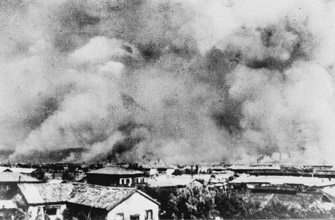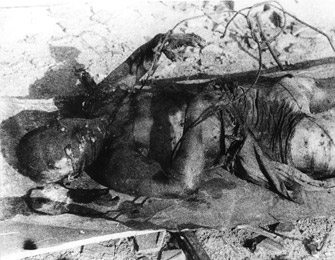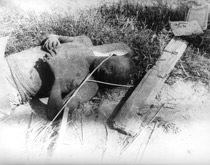City of Death
From the time the atomic bomb exploded on August 6, Hiroshima was a city of death. Anything combustible burned; it took three days for the fires to subside.

Hiroshima in flamesHiroshima City photographed from the 3rd floor of the Army Ship Training Headquarters in Ujina-machi on the day of the atomic bombingAugust 6 Ujina-machi 4,000m from the hypocenter Taken by Gonichi Kimura |

Hiroshima on the day after the atomic bombingPhotograph taken facing west from Hondori (facing the hypocenter)August 7 Hondori 500m from the hypocenter Taken by Mitsugi Kishida Courtesy of Teppei Kishida |

Deceased covered with mats at temporary crematoriumAugust 9-12Kako-machi 1,360m from the hypocenter Taken by Hajime Miyatake Courtesy of Asahi Shimbun |

Charred remains of the deceased with eyes protrudingWith the fierce pressure of the blast the air pressure in the area dropped instantaneously, resulting in eyeballs and internal organs popping out from bodies.August 10 Near Hiroshima Castle 500m from the hypocenter Taken by Satsuo Nakata |

Dead body lying on the groundAugust 10Near Hiroshima Castle 700-800m from the hypocenter Taken by Satsuo Nakata |
|

Black kites flying low near the remains of Chugoku Regional Military HeadquartersAugust 9-12 Moto-machi 860m from the hypocenterTaken by Hajime Miyatake Courtesy of Asahi Shimbun |

Collapsed bridge with pier remainingAugust 9-12 Honkawa Bridge 460m from the hypocenterTaken by Hajime Miyatake Courtesy of Asahi Shimbun |
